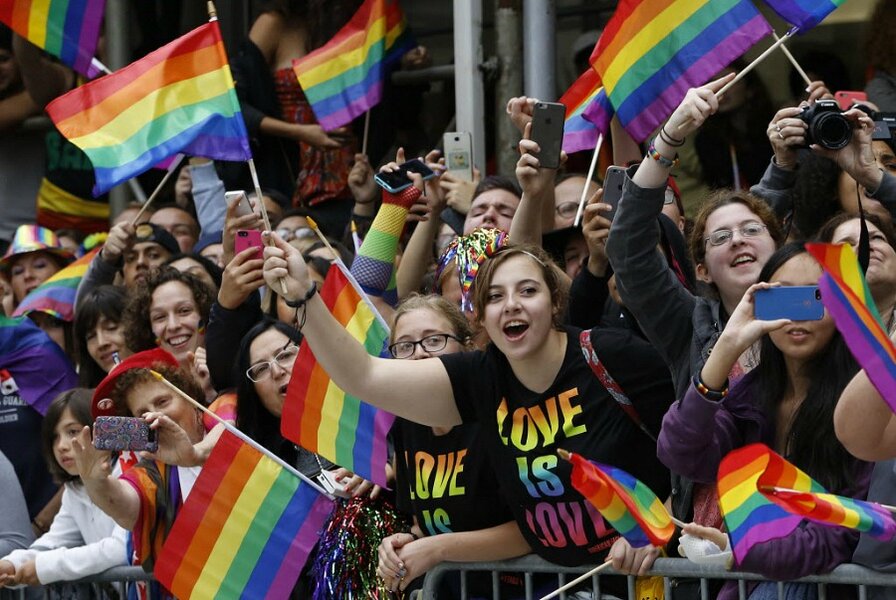Gay Pride Day celebrates rapidly accelerating advances in gay rights
Loading...
Just a few years ago, it seemed almost unthinkable: Expanding legal protections for gay men and lesbians, whose sexual orientation, physically expressed, was widely considered a crime as well as a sin. The US armed forces rapidly accommodating gay and transgendered service members. Same-sex marriage the law of the land.
With last week’s ground-breaking Supreme Court ruling on marriage, civil rights for gay Americans have been largely achieved, paralleling a change in public attitudes that has moved rapidly toward acceptance as courts and legislative bodies passed new laws or eliminated old ones.
Gay Pride Day, celebrated around the country Sunday, is in marked contrast to an event that occurred on the same date in 1969. Police raids on gay bars in New York – specifically the Stonewall Inn – set off spontaneous and violent demonstrations that popularized the slogan "Out of the closet and into the streets." A year later, marchers walked up Polk Street, and by 1972, the event had become a parade, with an estimated 2,000 marchers and 15,000 spectators, according to the San Francisco Chronicle.
Over the years, parades and other events spread around the United States and other countries. More importantly, judges and lawmakers began addressing hate crimes and discriminatory practices. In 2003, in a Texas case, the Supreme Court struck down state sodomy laws that had criminalized gay sex.
But it was the subject of marriage, with its profound historical, sociological, and religious implications, that became the focus of attention. In 2004, Massachusetts became the first state to pass what has come to be called by advocates a “freedom to marry” law. Within a decade, the number of states allowing same-sex marriage had grown to 37, plus the District of Columbia.
Last Friday, in a 5-4 decision, the Supreme Court extended that right to all Americans.
“The right to marry is a fundamental right inherent in the liberty of the person, and under the Due Process and Equal Protection Clauses of the Fourteenth Amendment couples of the same-sex may not be deprived of that right and that liberty,” Justice Anthony Kennedy wrote in the majority opinion.
“The court now holds that same-sex couples may exercise the fundamental right to marry,” he declared. “No longer may this liberty be denied to them.”
If the court had gone the other way – if conservative Kennedy had not joined the court’s four reliably liberal justices – Gay Pride Day this year would have been a very different event.
Instead, hundreds of thousands of people joyfully packed gay pride events from Chicago to New York City, Seattle to San Francisco. At gay pride parades in Paris and other cities outside the United States on Saturday, the Supreme Court's ruling was hailed by many as a watershed.
A parade that at times resembled a rainbow-colored dance party snaked Sunday through downtown San Francisco. Cheerleaders, dancers, and proud families of lesbians and gays swooped up Market Street as spectators flocked 10 to 15 people deep along both sides. There were "Hooray for Gay" and "Love Won" signs. There were rainbow flags and knee socks, umbrellas and tutus.
Seattle's gay pride celebration has evolved from a political parade to a family event featuring bounce houses, free ice cream, and marching Boy Scouts and cheerleaders. Organizers were expecting to draw nearly 500,000 Sunday to watch a parade through downtown Seattle and participate in a picnic and family-friendly entertainment at nearby parks.
More than 1 million people attended Chicago's parade last year – the first parade after same-sex marriage became legal in Illinois – and even more people were expected Sunday. Among those making an appearance were Democratic Chicago Mayor Rahm Emanuel, Republican US Sen. Mark Kirk and the Stanley Cup, which rode on a float along with representatives of the Chicago Blackhawks.
A large and boisterous crowd turned out to celebrate at the annual gay pride parade in Minneapolis. Sidewalks were wall-to-wall with spectators, and the rooftop dining and drinking spots were jammed with onlookers. Police officers at the front of the procession held US and Pride rainbow flags aloft. Glitter was thrown from the rooftops, fluttering to the street below. Minneapolis Mayor Betsy Hodges rode in the parade on a motorcycle.
Meanwhile, advocates for lesbian, gay, bisexual, and transgender (LGBT) Americans vow to keep pushing against any remaining laws and practices based on bias.
“Our work isn’t done until every discriminatory law in this nation is wiped away,” Human Rights Campaign president Chad Griffin when the high court ruled for gay marriage last Friday.
“The time has come in this country for comprehensive federal LGBT non-discrimination protections,” he said. “We now have to work harder than ever before to make sure LGBT Americans cannot be fired, evicted or denied services simply on the basis of the marriage license that they fought so hard to achieve.”
This report includes material from the Associated Press.






